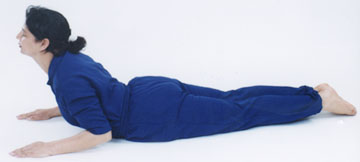|
Aspects: This asan is called Bhujangasan as the posture resembles a Cobra. A serpents body is extremely flexible. Naturally this asan makes our body quite flexible. While doing Suptvajrasan, the hands are stretched beyond the head resulting in the sufficient flow. The most important point to be kept in mind here is that while attaining the final position the breath should be inhaled completely. While raising the frontal part of the body, do it in two stages (a) Bending the neck backward (b) Raising the trunk. Similarly the return movement also should be in two stages (c) First lowering of the trunk and (d) Then bending the head and forehead towards the ground. Do not bend the neck when lowering the trunk, keep the neck stretched backward. While doing this asan, there should be minimum weight on the palms but maximum pressure on the pelvic region. This way the asan gives the maximum benefit. And this is also a good indication of perfection. While practicing this asan, there should be no gap between the heels and that the toes should also remain stretched.

Technique:
Lie down on the abdomen. Bring the heels and toes together and stretch them to the maximum. Now bend the elbows and place the palms on either side of the chin. The gap between the palms may be equal to the gap between the shoulders. Pull back the elbows as much as possible, touching the body, and resting on the ground, the position of arms should not change, the forehead should touch the ground.

|
Inhaling, bring the chin forward & start raising the head as far back as possible, so much so that it may touch the spine. Now inhaling raise the chest and abdomen up to the naval. Breathe normally and stay in this posture. While exhaling lower the trunk very slowly but not the head. When trunk comes down completely, rest the forehead on the ground. Thereafter relax in Shithilasan.
|
|